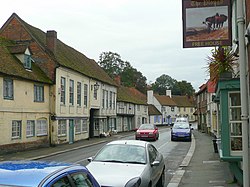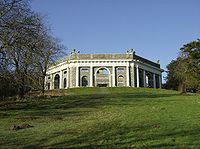West Wycombe
| West Wycombe | |
| Buckinghamshire | |
|---|---|
 High Street, West Wycombe | |
| Location | |
| Grid reference: | SU830945 |
| Location: | 51°38’35"N, -0°47’59"W |
| Data | |
| Population: | 1,345 (2011) |
| Post town: | High Wycombe |
| Postcode: | HP14 |
| Dialling code: | 01494 |
| Local Government | |
| Council: | Buckinghamshire |
| Parliamentary constituency: |
Wycombe |
West Wycombe is a small village in Buckinghamshire, found along the A40 road, three miles west of High Wycombe.
The historic village is largely a National Trust property and receives a large annual influx of tourists - being the site of West Wycombe Park, the Hellfire Caves and the Mausoleum on top of West Wycombe Hill. The Mausoleum and Golden Ball above West Wycombe village are impressive local landmarks, visually dominating the village and local landscape for miles surrounding.
West Wycombe Park, Caves, Mausoleum and St Lawrence's Church were all built in the mid-18th century by Sir Francis Dashwood, founder of the Dilettanti Society and co-founder of the notorious Hellfire Club, from which the West Wycombe Caves he excavated take their more familiar name.
History
Early history
The hill above West Wycombe (now the site of St Lawrence's Church and the Mausoleum) has been continuously inhabited for centuries. A Bronze Age settlement is widely believed to have existed here. A Roman settlement later occupied West Wycombe Hill.
The lost village of Haveringdon
In the Anglo-Saxon period there was a village on the hillside believed to have been named Hæferingadun (meaning Hill of Haefer's people in Old English). The name later evolved into Haveringdon. A church is said to have been built at Haveringdon by Birnius, who later became the bishop of the West Saxons in AD 635. A Norman watch tower is also said to have been built on top of the hill.
Haveringdon's population is believed to have been greatly reduced by the Black Death) in the 1340s. By the 18th century the village had been resited in the valley along the Oxford Road, and renamed 'West Wycombe' form its position west of High Wycombe. According to local records there were just two ratepayers left in Haveringdon in the 19th century.
Georgian Era

In the mid 18th century Sir Francis Dashwood commissioned an ambitious project to supply chalk for a three-mile straight road between West Wycombe and High Wycombe, now part of the A40 road, then a prominent trade route between London, Oxford and Gloucester and onward to Glamorgan. The local chalk cave which had been in the village since prehistoric times was expanded into an elaborate network of tunnels and passages. The design of the caves was mostly inspired by Dashwood's Grand Tour of Italy, Greece and the Ottoman Empire.
Local villagers, impoverished after a series of harvest failures, were paid a shilling per day to tunnel underground to mine chalk. The caves were all excavated by hand and even today they are viewed as an incredible feat of engineering.
Dashwood's family home, West Wycombe House, also underwent major alterations at this time. Although Haveringdon had all but disappeared by then, the church and tower had remained and a centre section was built to join the two together. The Mausoleum was also constructed, based on the design of the Constantine Arch in Rome. The new church was named Saint Lawrence's. The church and Mausoleum were also built using chalk and flint from the caves.
During this time, Dashwood and other high-powered politicians and society members formed a club then known as The Knights of St. Francis (which was later named as the Hellfire Club by a London newspaper). They first used Medmenham Abbey, eight miles away from West Wycombe on the River Thames, but the caves were later used for the club's meetings. The club was notorious in its day for orgies and black magic, but had disbanded by 1763 (according to church records). The caves fell into disuse and disrepair.
West Wycombe in the 20th century
In 1929 West Wycombe village was put up for sale by the Dashwood family to raise cash following that year's Wall Street Crash. It was bought in its entirety by the Royal Society for the Encouragement of Arts, Manufactures and Commerce (better known as the Royal Society of Arts, or simply the RSA) as part of the Society's "Campaign for the Preservation of Ancient Cottages". In 1934, after extensive repairs, the Society handed the property over to the National Trust. The National Trust markets this property under the name 'West Wycombe Village and Hill'. The property features many buildings of architectural value which were built between the 16th and 18th centuries.
Between 1906 and 1958 the village was served by West Wycombe railway station, to the east of the village, on the Chiltern Main Line between London and Birmingham.
In the late 1940s and early 1950s the caves underwent extensive repairs under the auspices of the Dashwood family and turned into a tourist attraction. The profit earned was used to renovate the dilapidated West Wycombe Park. The caves continue to thrive as a popular tourist attraction today and have received over 2 million visitors since their reopening in 1951.
West Wycombe today
Although it is on the busy A40, the village centre retains much of its historical charm. It is mainly owned by the National Trust, and so has resisted modernisation. The High Street has a number of 'old-fashioned' shops (in appearance at least), as well as three pubs, some small offices and a well-used village hall. Just off the High Street are the village Combined School (ages 4–11) and a traditional garden centre. The population is around 1,300.
West Wycombe on film and television
The village and West Wycombe Park have been used as a location for numerous films, most notably:
- The Duchess
- The Importance of Being Earnest
- I Capture the Castle
- Dead Man's Folly
The BBC TV adaptation of Elizabeth Gaskell's novel Cranford was partly filmed at West Wycombe Park, along with TV series Inspector Morse.
The Mausoleum was used as the set of a Roman town in an episode of the BBC Children's show Chucklevision and was used as a location in the biblical fantasy scenes for A Clockwork Orange.
See also
Outside links
| ("Wikimedia Commons" has material about West Wycombe) |
- West Wycombe Village and Hill information at the National Trust
- West Wycombe Estate Sawmill House and others. Accessed July 2007
- West Wycombe in the Domesday Book
- Photographs of Dashwood's tunnels in West Wycombe
- West Wycombe Parish Council
